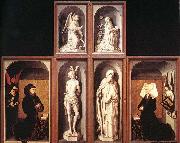|
|
|
|
|
WEYDEN, Rogier van der
|
|
The_Last_Judgment_Polyptych
|
|
|
|
|
|
|
|

|
|
Click to Enlarge
|
| WEYDEN,_Rogier_van_der
|
The Last Judgment Polyptych
new21/WEYDEN, Rogier van der-457853.jpg
|
|
|
|
|
|
| 1446-52 Oil on wood Mus?e de l'H?tel Dieu, Beaune As long as the polyptych hung in its original place, it was traditional to open the wings on Sundays and solemn feast days. But since it has been restored, it is now kept in a neighbouring room which is air-conditioned to prevent any further deterioration due to the heat generated by the three hundred thousand visitors who come to see it each year. The panels were sawn in half across the thickness of the wood a few years ago, and both front and the reverse are now exhibited simultaneously, side by side. The reverse of the panels of the polyptych depict the donors. Nicolas Rolin is an old man, whose nose is too long and whose hair has been cut short. Guigonne de Salins lowers her eyes and gestures with her joined hands towards her book of hours; on her head she wears a starched net veil. Behind each of them, an angel is carrying a shield emblazoned with their respective coats-of-arms. Rolin is facing towards an elegant imitation statue of St Sebastian executed in grey tint, as if carved from marble. His wife is looking towards another imitation statue, this time of St Anthony, who is accompanied by a young pig.Artist:WEYDEN, Rogier van der Title: The Last Judgment Polyptych (reverse side) Painted in 1401-1450 , Flemish - - painting : religious |
|
|
Netherlandish Northern Renaissance Painter, ca.1400-1464
major early Flemish master, known also as Roger de la Pasture. He is believed to have studied with Robert Campin. His early works also show the influence of Jan van Eyck. Van Eyck, however, had been a master at objective rendering of detail, whereas Roger in his work portrayed emotions with an assurance that has not been surpassed. His ability to depict piety is reflected in the early masterpiece Descent from the Cross (c.1435; Prado); he depicted with significant restraint the profound grief of the mourners grouped around the tragic figure of Jesus. His composition strongly affected later representations of the theme. Roger became City Painter in Brussels in 1436. He then produced a series of undated altarpieces including the Last Judgment (hospital, Beaune), the Braque Triptych (Louvre), Crucifixion with Donors (Vienna), and Adoration of the Magi (Berlin), which vary in execution from a stress on sumptuous details to a more sculptural rendering of the figures. Roger is believed to have made a pilgrimage to Italy in the holy year 1450. Whether this supposed excursion had any effect on his style is much debated. It has been shown that his Entombment (Uffizi) bears an affinity to the Tuscan treatment of the subject, particularly by Fra Angelico, and that Roger's Virgin and Child with Saints (Frankfurt) has a strong resemblance to the Italian religious art of the day. His style is, however, highly individual. His religious paintings and his portraits are characterized by a straightforward monumentality. The portraits, such as that of a young lady (National Gall. of Art, Washington, D.C.) and of Francesco d'Este (Metropolitan Mus.) exhibit a simple clarity of contour and psychological penetration. Other notable works are his St. Luke Painting the Virgin, of which a version or replica is in the Museum of Fine Arts, Boston, the Crucifixion
|
|
|
|
|
|
|